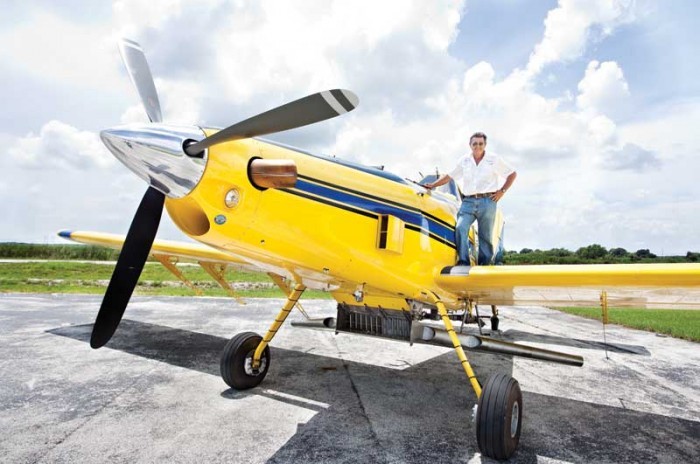
VERO BEACH — Activity on the barrier island typically slows during the dog days of summer. Traffic is at a minimum, the beaches bring out sun worshipers enjoying the weather, and the weather creates thunderstorms that bring out something else – mosquitoes and their arch-rival, a powerful, yellow, single-engine aircraft.
You know the plane, the one that sometimes can be seen disappearing below the tree-tops when you are on the golf course? Or that almost seems likely to leave tire marks on car roofs as it swoops low over the marshy areas just north of the Barber Bridge?
The plane that emits a throaty roar, looking all the world like a P-40 Warhawk or a P-51D Mustang, evoking images of a World War II plane making a strafing run?
Yes, that plane – known to some as the Yellow Baron.
It is easy to imagine a leather-jacketed man with goggles on his forehead stepping out of that plane – perhaps a cross between Errol Flynn and Charles Lindberg.
However, the pilot of this plane is no daredevil; he’s Randy Berry of Southeastern Aerial Crop Services, and he sprays something called “larvicide” for the Indian River Mosquito Control District.
“A lot of people don’t understand – everything I do is methodical even though it may look radical from the ground,” said Berry, who’s been a pilot for more than four decades. “I stay between 200-300 feet and my patterns are made with precision turns. The plane burns 70 gallons of fuel per hour, so it isn’t like I’m up in the air to go sight-seeing.”
That thirsty plane is an Air Tractor, outfitted with a powerful 720 horsepower Pratt & Whitney jet engine with front-mounted propeller.
The plane’s hopper has a capacity of 500 gallons in which it can store larvicide, pesticide, or whatever Berry needs to spread or spray during his flight.
The aircraft retails for $850,000, and is equipped with a state-of-the-art Global Positioning System and spreading devices.
“We use a GPS guide which is accurate within three inches anywhere in the world,” Berry said. “When I’m flying (usually at 130 to 140 miles per hour), the plane will monitor my swath, when the spray is on or off, and if I’m getting too wide when I spread. It will tell me exactly how many feet I am off of on my line.”
He paused, then added: “Someone may say I flew over their house. Well, not only does the system show where I’m spraying, it also shows my little track when I am not. The information downloads on a USB drive and I take it in to the office to be downloaded. Big Brother is watching the whole time. The old days of radial engines and circus performers are over; this is very high tech stuff.”
“We have some no-fly zones for various reasons,” he says, “particularly over by John’s Island. And even though it takes a little more time do the job, I try to appease the residents of John’s Island by not flying over that area. It is a courtesy to them, and after all, what we do is a public service – it’s not like we’re mongers of the air. We are professionals who care about the community and we are very involved in it.”
Berry himself is a former president of a 1500-person builders association of Indian River, Martin, St. Lucie and Okeechobee Counties.
“What Southeastern Aerial Crop Services does for us is called larviciding. It kills mosquito larvae when they are still in the water,” said Doug Carlson, director of the Indian River Mosquito Control District. “It treats salt marsh areas where mosquitoes are present, and we have people check the grounds and report when larvae are there. We relay instructions to Randy where exactly he needs to apply treatment and when we need him to do it.”
“We use granular materials, 10-12 pounds of material per acre, and we strictly spread it in the Indian River lagoon,” Carlson added.
The Indian River Mosquito Control District was the first of its kind in the state when it was created in 1925, and it coincided with the creation of Indian River County itself.
“Our district has used Southeastern now for the past five or six years, and they do a very fine job for us,” Carlson said.



